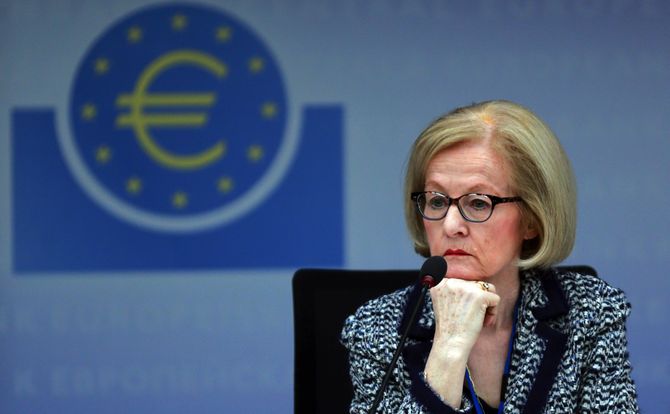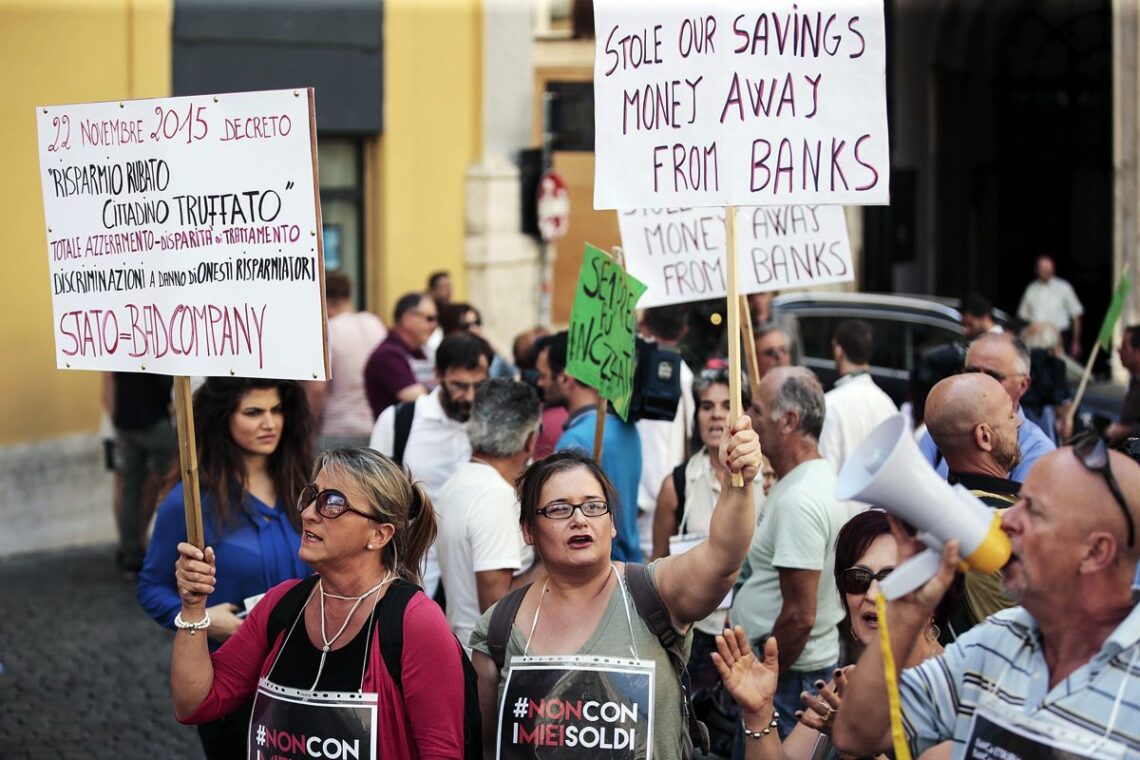Orderly failure: The EU’s Bank Recovery and Resolution Directive
After the financial crisis, governments are wary about bailing out distressed banks with taxpayer money. But the bail-in procedures implemented in 2016 by the EU have their own drawbacks. If new proposals are adopted to give resolution authorities more preemptive powers, they will give technocrats unprecedented control.

In a nutshell
- The EU has shifted from a bailout to a bail-in approach to bank failures
- The BRRD directive focuses on early interventions to avoid costly resolutions
- The system seems to work for “idiosyncratic” failures but is untested by a major one
Faced with a cascade of banking failures in 2008-2012, European authorities decided to rescue most lenders through multibillion-euro government bailouts. Crisis management had to occur on a political level, mostly under extreme time pressure, with the absolute priority of preventing chaos from spreading into a wider economy that was already severely depressed.
Ten years later, the idea that governments must ride to the rescue of distressed banks to preserve financial stability has gone out of fashion. The disruptive effect of such bailouts on public finances and their contribution to rising sovereign debt are usually put forward as arguments against such assistance.
Moral hazard is another. This concept refers to circumstances under which economic actors (financial firms) are incentivized to take risks precisely because they are assured that someone else (in this case, hapless taxpayers) will bear the costs if anything goes wrong.
Regime change
Forcing taxpayers to shoulder the heavy burden of bank failures – in other words, privatizing profits and socializing losses – is no longer economically and morally acceptable in today’s regulatory culture. Banks, like any other agent operating in a market economy, are expected to face their responsibilities and internalize the risks they take. This helps explain the recent institution and enforcement in many countries of so-called bail-in regimes, which uphold the principle of private penalty instead of implicit public guarantees.
The United States, for instance, adopted the Dodd-Frank Act in 2010. Besides increasing banks’ minimum capital requirements, this legislation sets a statutory liquidation process based on bail-ins.
A major focus of the BRRD is early intervention, detecting banks’ weaknesses early on and proposing remedies.
The European Union followed this American lead in 2014 by adopting the Bank Recovery and Resolution Directive (BRRD), a key piece of legislation for the eurozone’s emerging Banking Union, whose first two pillars call for a coordinated single mechanism for banking supervision and, if necessary, common bank resolution tools for the euro area.
The BRRD came into force on January 1, 2016, after six member states – the Czech Republic, Luxembourg, the Netherlands, Poland, Romania and Sweden – were referred to the European Court of Justice for delaying its transposition into national law. As a result, if a banking crisis were to occur in Europe today, bail-in should be the rule and bailout the exception.
Failure simulation
A major focus of the BRRD is forecasting and early intervention. The idea is to minimize the need for banking resolution, which is always costly and disruptive. Each financial institution, whatever its state of health, is thus required to formulate detailed “recovery and resolution plans” on an annual basis. They should be based on credible failure scenarios (so-called “dry runs”) and formulate suggestions (“living wills”) on how to handle worst-case outcomes.
The national resolution authorities, on their side, draw up their own versions of such hypothetical bankruptcy plans for each bank. The purpose is to detect weaknesses in the banks’ projections early on and propose remedies, such as raising more capital, reducing lending or selling assets.
Supposedly, the process involves the exchange of thousands of pages of documents between banks and supervisors. This “supervisory dialogue” is closely monitored by the European Central Bank (ECB), confirming its role as the supreme authority in EU banking supervision.
The ECB enjoys extensive powers of investigation and sanction to ensure commercial banks’ compliance.
By law, the central bank enjoys extensive powers of investigation and sanction to ensure commercial banks’ compliance with EU prudential rules. In addition to carrying out annual EU-wide stress tests, the ECB can conduct on-site inspections, set higher capital requirements (“buffers”) for some lenders, grant or withdraw banking licenses and even impose sanctions on noncompliant institutions.
All these measures are intended to keep the banking sector “safe and sound,” as Daniele Nouy, who chairs the ECB’s Supervisory Board, explained to a banking conference in September 2017. She added, however, that the ECB’s job “is not to prevent each and every bank from failing.” Instead, it would let failures occur “in an orderly fashion.”
Insolvency frameworks
Unsurprisingly, only the ECB can trigger a bank resolution process under the 2014 directive. The BRRD deems a bank “failing or likely to fail” if certain conditions are met or “likely to be met” – for instance, if the bank has more liabilities than assets, is unable to pay its debts, or requires extraordinary public financial support.
Five banks have been declared failing or likely to fail under this regime so far: Banco Popular in Spain, Veneto Banca and Banca Popolare di Vicenza in Italy, and most recently, Latvia’s ABLV Bank and a subsidiary in Luxembourg.
Once a bank falls under the classification, the Single Resolution Board (SRB), a body specifically designed to resolve banks in difficulty, evaluates whether conditions for resolution are met or whether private solutions (such as a merger/acquisition or capital injection) can prevent failure.
If resolution cannot be avoided, the SRB determines the “public interest;” for example, does the bank perform “critical functions” or would its liquidation adversely impact financial stability? Resolution under the BRRD occurs only if it is in the public interest. Otherwise, the bank is liquidated under national insolvency law.

The ECB, for its part, is concerned that national insolvency frameworks are poorly harmonized, which might lead to unsatisfactory outcomes at the EU level. The case of ABLV and its Luxembourg subsidiary is sometimes cited as showing a “misalignment” between the triggers for resolution under the BRRD and national law.
However, it was the ECB’s decision to pull the trigger on Latvia’s third-largest bank while leaving resolution to national insolvency law. ABLV protested that it had raised enough liquidity to meet all obligations toward clients. But with the lender embroiled in a money-laundering scandal tied to North Korea, many saw its closure as a political decision to enforce the sanctions regime against Pyongyang. This made ABLV the latest victim of what Bloomberg News has called the “ECB death penalty.”
Strictly speaking, the complete BRRD process has been tested only once so far, when Spain’s Banco Popular was purchased by Banco Santander for a symbolic 1 euro. Most other banking resolutions, including the previously mentioned Italian and Latvian examples, have been handled under ordinary national insolvency procedures.
Resolution schemes
Four techniques can be used for BRRD resolutions, alone or in combination. The failed bank (or parts of it) can be sold, as with Banco Popular; transferred to a temporary entity (“bridge bank”); split into a “good” bank (which maintains core operations) and a “bad” bank (which winds down distressed assets over time); or subjected to a bail-in procedure, which requires the bank’s creditors to absorb losses.
Bad-bank operations can be difficult, as shown by Portugal’s resolution of Banco Espirito Santo in 2015. (The BRRD was already in place at the time, but the Single Resolution Board was not yet operational.) The Bank of Portugal, in charge of the liquidation, was accused of discriminating against foreign investors. Foreign-owned assets went straight into the bad bank (to be wound down), while those held by domestic customers were transferred to the good one, Banco Novo. Foreign bondholders were not the only ones to lose big in this fiasco; Portugal’s image as an investment destination also suffered considerably.
Pecking order
In the event of a bail-in, a pre-designed hierarchy determines who is required to pay. First come the bank’s shareholders, then bondholders and, lastly, unsecured depositors – anyone with more than 100,000 euros in a bank account.
Protected deposits should be the next in line, but these are covered by national deposit guarantee schemes (DGSs), which in this case are treated as bail-in-able creditors. For now, not all national schemes are sufficiently funded to reimburse all secured deposits, which could prove troublesome if a big multinational bank fails, or if several large banks in the same member state get in trouble.
The directive’s basic rationale is to create incentives for all market participants to minimize risks.
The European Banking Authority insists, however, that deposits of less than 100,000 euros will be protected “in all circumstances and regardless of the current level of available financial means.” This implies that the BRRD does not rule out additional public financing to support deposit guarantees. Article 58 of the directive even allows for “temporary public ownership” of failing banks in the event of “very extraordinary situations of systemic crises.”
In the very last resort, the European Stability Mechanism (ESM) bailout fund may step in to help eurozone countries in severe financial distress. If a political agreement is reached, the ESM might one day be transformed into a European Monetary Fund.
Market incentives
The rationale behind the BRRD is above all to create incentives for all market participants to minimize risks. The threat of being partially expropriated in a resolution should force creditors to resume their function of monitoring and disciplining commercial banks’ activities.
The argument makes sense. Yet it may be far-fetched to think that ordinary bank customers, such as savers and pensioners, have the expertise to exercise a proactive monitoring role. At most, they receive upbeat, laconic disclosures outlining the bank’s (generally successful) business activities. Little can be known about what really goes on behind the bank’s glass walls and what risks are being taken with clients’ money.
By law, all account holders receive information about the BRRD’s provisions (up to including a copy of the 159-page directive), but few seem to realize the risks they take when buying bonds or depositing their money.
If market logic truly applied, one would expect lenders to pay an appropriate risk premium to bail-in-able creditors. Strangely, depositors’ risks go completely unremunerated in today’s near-zero interest rate environment. In our world of financial repression (imposed largely by the ECB’s ultra-loose monetary policy), depositing a large sum in a bank seems almost an irrational act of faith.
Creditor flight
One incentive the bail-in system creates is for creditors who get wind of their bank’s difficulties to withdraw their deposits or sell their shares or bonds right away. Of course, by doing so, they risk worsening the condition of both the individual lender and the entire banking system, since the panic may quickly prove contagious. In this sense, the bail-in approach can help trigger a systemic crisis instead of averting one.
To prevent dangerous runs on banks, bail-ins will probably be instituted overnight to take creditors by surprise. If they were to involve several troubled banks at once, the shock waves could spread through the financial system – stretching the bail-in system beyond its limits.
‘Idiosyncratic’ vs. systemic failure
Europe has experienced no major banking failures since the BRRD came into force. Except for the already mentioned Banco Popular case, its key resolution tools – however good they look on paper – remain largely untested. What would happen if the European banking authorities had to handle the failure of a systemically important bank? Would the BRRD work if a crisis on the scale of 2008 were to reoccur? Only time will answer these questions.
As explained by economist Charles Goodhart, a former member of the Bank of England’s Monetary Policy Council, bail-ins have clear advantages over bailouts in cases of “idiosyncratic” bank failures (involving fraud or severe mismanagement, for example). In the event of a “large, complex, cross-border bank,” however, or when there is a threat of “systemic collapse,” the bail-in approach entails important risks and potentially high costs. Under taxpayer-funded bailouts, Goodhart writes, everyone’s tax liabilities increase a little; whereas in a bail-in, a few lose a lot. The latter have stronger incentives to litigate, and if they win, their losses often end up being paid by taxpayers, anyway.
The bailouts of 2008-2012 came at a high cost to European taxpayers, though most of the money was repaid.
The bailouts of 2008-2012 came at a high cost for European taxpayers – some 590 billion euros, according to the ECB. What has not been much commented upon is that most of this aid has been repaid to governments by financial institutions, and yet taxpayers have not seen any of this money come back to them. This should be kept in mind when one weighs the fairness and efficiency of bail-in and bailout regimes.
Preemptive tools
Whatever its drawbacks, the BRRD is here to stay. It has even been amended under a new directive (BRRD 2). Further updates have been proposed and are being considered. All seem to favor a hard-line stance in the evolution of European banking regulation. In policy circles, it is argued that being too cautious or “soft” about using the BRRD could be counterproductive when a systemic threat arises and creditors rush for the door.
Suggestions on how to counter the creditor flight problem were made by ECB President Mario Draghi in Point 5.3 of a November 2017 opinion on revising the crisis management framework. This would allow the authorities to temporarily freeze accounts even before triggering a bank’s resolution. In May 2018, the European Parliament and the Council proposed that this consequential recommendation be incorporated into the BRRD’s Article 33a.
Policymakers are now debating at what stage and for how long such “pre-resolution moratorium tools” could be introduced, and whether they would apply to all or only some deposits. Mr. Draghi prefers the former option, suggesting that depositors could be allowed “to withdraw a limited amount of deposits on a daily basis.”
Whatever is decided, the EU’s readiness to keep tinkering with the BRRD gives unprecedented scope for technocratic control of the banking industry.








